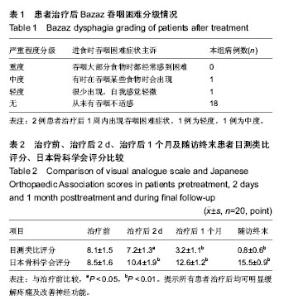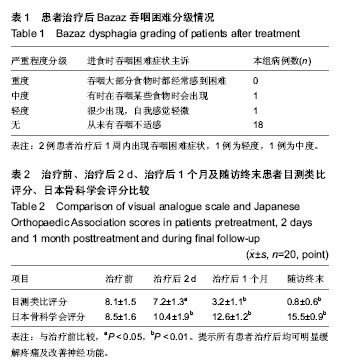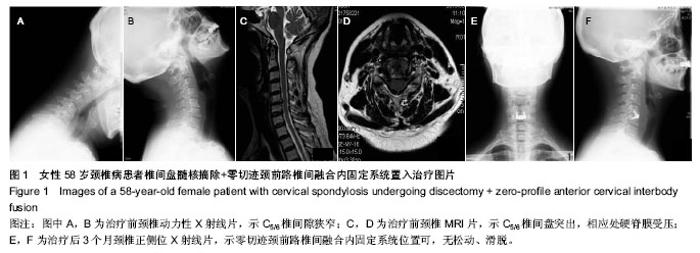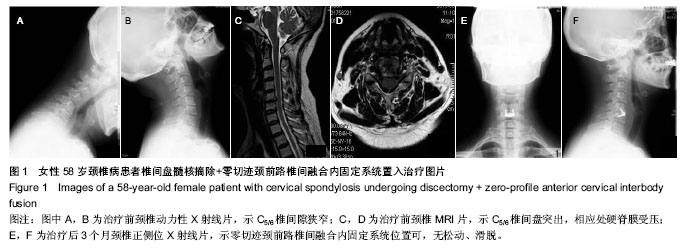| [1] Matz PG, Ryken TC, Grof MW, et al.Techniques for anterior cervical decompression for radiculopathy.J Neurosurg Spine. 2009;11(2):183-197.
[2] Pitzen TR, Chrobok J, Stulik J, et al.Implant complications,fusion,loss of lordosis,and out come after anterior cervical plating with dynamic orrigid plates:two-year results of a muhicentric,randomized,controlled study. Spine. 2009;34(7):641-646.
[3] Kaiser MG, Haid RW Jr, Subach BR, et al. Anterior cervical plating enhances arthrodesis after discectomy and fusion with cortical allograft. Neurosurgery. 2002;50(2):229-236.
[4] Yang JY, Song HS, Lee M, et al. Adjacent level ossification development after anterior cervical fusion without plate fixation. Spine. 2009;34(1):30-33.
[5] Fujiwara A,Kobayashi N,Saiki K,et al.Association of the Japanese Orthopaedic Association score with the Oswestry Disability Index,Roland-Morris Disability Questionnaire,and short-form 36. Spine. 2003;28(14):1601-1607.
[6] Bazaz M,Lee M,Yoo JU. Incidence of dysphagia after anterior cervical spine surgery:a prospective study. Spine. 2002; 27 (22): 2453-2458.
[7] 刘才俊,吴增晖,张奎渤,等.零切迹椎间融合内固定系统Zero-p在颈椎前路手术中的应用[J].中国骨科临床与基础研究杂志,2012, 4(3):178-183.
[8] 贺瑞,尚希福,张文志,等.零切迹颈前路椎间融合固定系统在颈前路融合术中的初步应用[J].颈腰痛杂志,2012,33(2):92-94.
[9] Korinth MC. Treatment of cervical degenerative disc disease-current status and trends. Zentralbl Neurochir. 2008; 69(3):113-124.
[10] Scholz M,Reyes PM,Schleicher P,et al.A new stand-alone cervical anterior interbody fusion device:biomechanical comparison with established anterior cervical fixation devices.Spine. 2009;34(2):156-160.
[11] Scholz M,Schnake KJ,Pingel A,et al. A new zero-profile implant for stand-alone anterior cervical interbody fusion. Clin Orthop Relat Res. 2011;469(3):666-673.
[12] 俞武良,陆建猛,韦勇力,等.零切迹椎间融合固定系统治疗颈椎间盘突出症的早期疗效观察[J].脊柱脊髓修复与功能重建,2013, 27(6):686-689.
[13] 廖壮文,黄彦,范子文,等.微创小切口零切迹颈前路椎间融合器治疗单阶段脊髓型颈椎病的疗效评价[J].中国矫形外科杂志,2012, 20(24):2250-2254.
[14] 陈智,黄轩,李凤宁,等.颈椎前路术后吞咽困难的相关因素分析[J].中国脊柱脊髓杂志,2012,22(11):979-983.
[15] 祁敏,王新伟,刘洋,等.三种颈前路减压术式治疗多节段脊髓型颈椎病的并发症比较[J].中国脊柱脊髓杂志,2012,22(11):963-968.
[16] Schmidt M,Maxime V,Pareire F,et al.A lethal case of meningitis due to Lactobacillus rhamnosus as a late complication of anterior cervical spine surgery.Infection. 2011; 62(4):309-310.
[17] 金大地,王健,瞿东滨.颈椎前路手术早期并发症原因分析及对策[J].中华骨科杂志,2005,25(2):102-106.
[18] 缪锦浩,匡勇,陈德玉,等.颈前路减压零切迹椎间植骨融合内固定系统治疗颈椎病的早期疗效分析[J].中国脊柱脊髓杂志,2012, 22(6):536-540.
[19] 刘斌,贺永雄,张沛,等.脊柱减压手术术后并发迟发性脊髓损伤3例报告[J].中华骨科杂志,2009,29(12):1148-1150.
[20] 陈雄生,贾连顺,曹师锋,等.颈椎前路手术的并发症[J].中华骨科杂志,2003,23(11):644-649.
[21] Lee MJ,Bazaz R,Furey CG,et al.Influence of anterior cervical plate design on dysphagia: a 2-year prospective longitudinal follow-up study. J Spinal Disord Tech. 2005;18(5):406-409.
[22] Yue WM,Brodner W,Highland TR.Persistent swallowing and voice problems after anterior cervical discectomy and fusion with allograft and plating:a 5-to 11-year follow-up study.Eur Spine J. 2005;14(7): 677-682.
[23] Smith-Hammond CA,New KC,Pietrobon R,et al.Prospective analysis of incidence and risk factors of dysphagia in spine surgery patients: comparison of anterior cervical,posterior cervical,and lumbar procedures.Spine. 2004;29(13):1441- 1446.
[24] Baron EM, Soliman AM, Gaughan JP, et al.Dysphagia, hoarseness, and unilateral true vocal fold motion impairment following anterior cervical diskectomy and fusion. Ann Otol Rhinol Laryngol. 2003;112(11):921.
[25] 祁敏,陈华江,杨立利,等.采用新型Zero-p颈椎椎间融合器置入治疗颈椎病的近期疗效分析[J].中国矫形外科杂志,2012,20(24): 2232-2236.
[26] 赵胜豪,郭卫春,陈家禄,等.人工颈椎间盘置换与颈前路减压融合术治疗脊髓型颈椎病的疗效比较[J].中国矫形外科杂志,2010, 18(20):1682-1685. |



